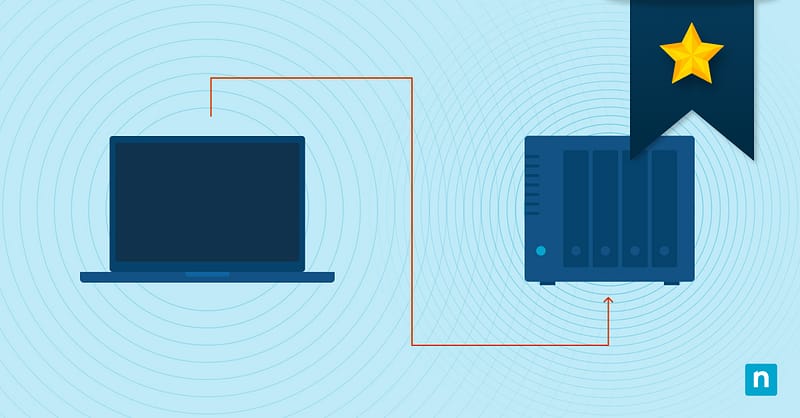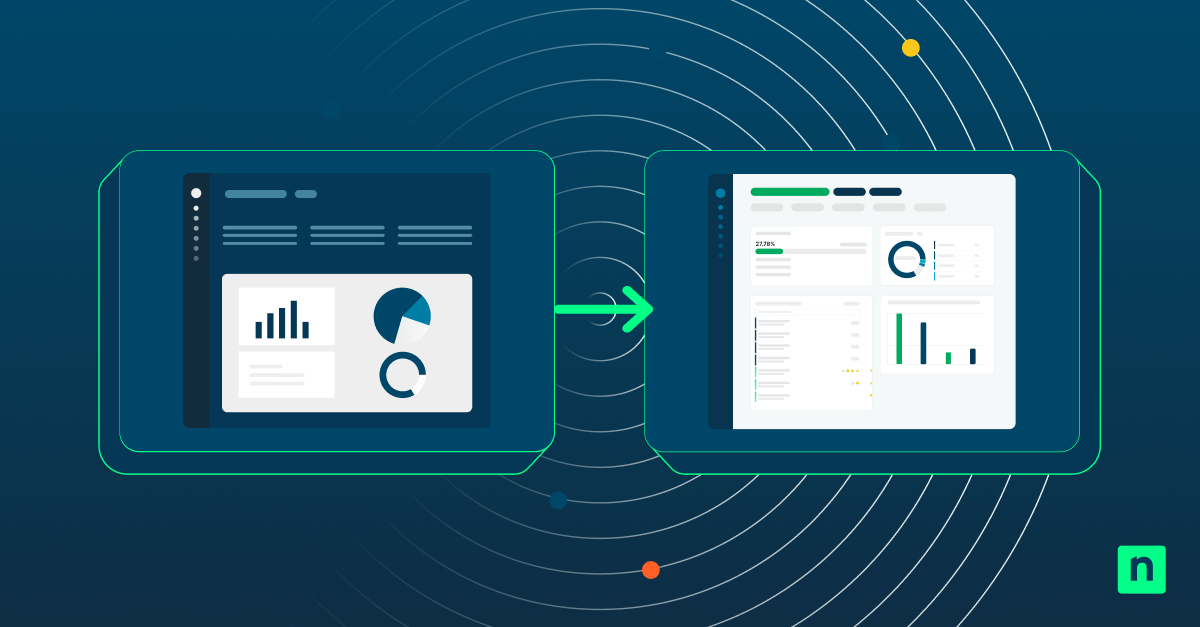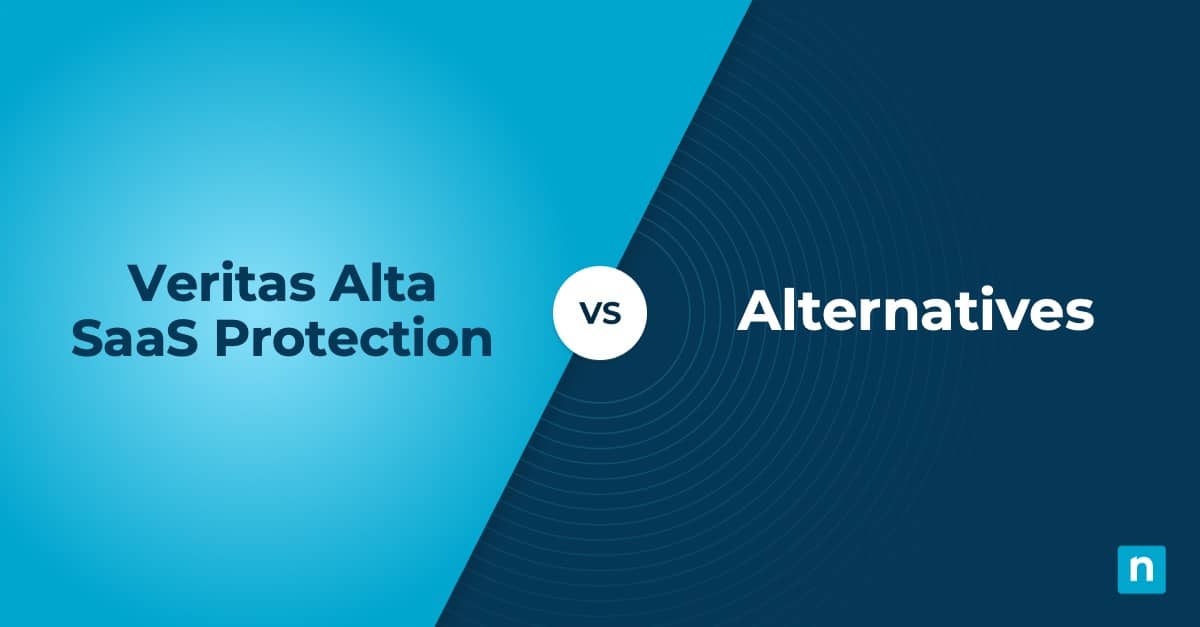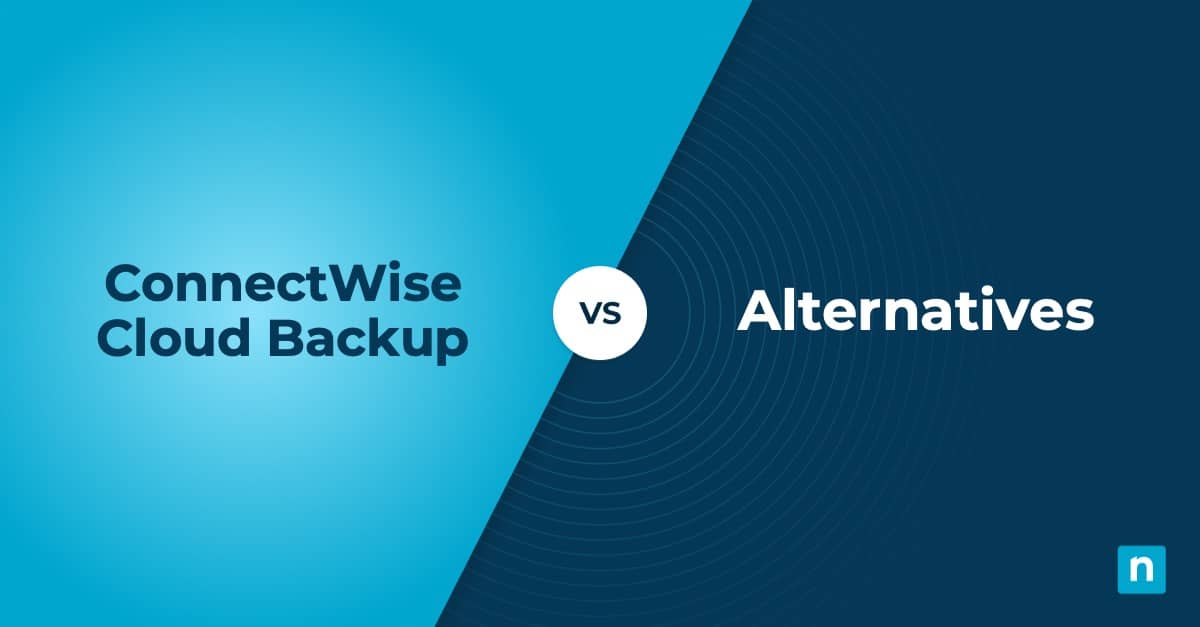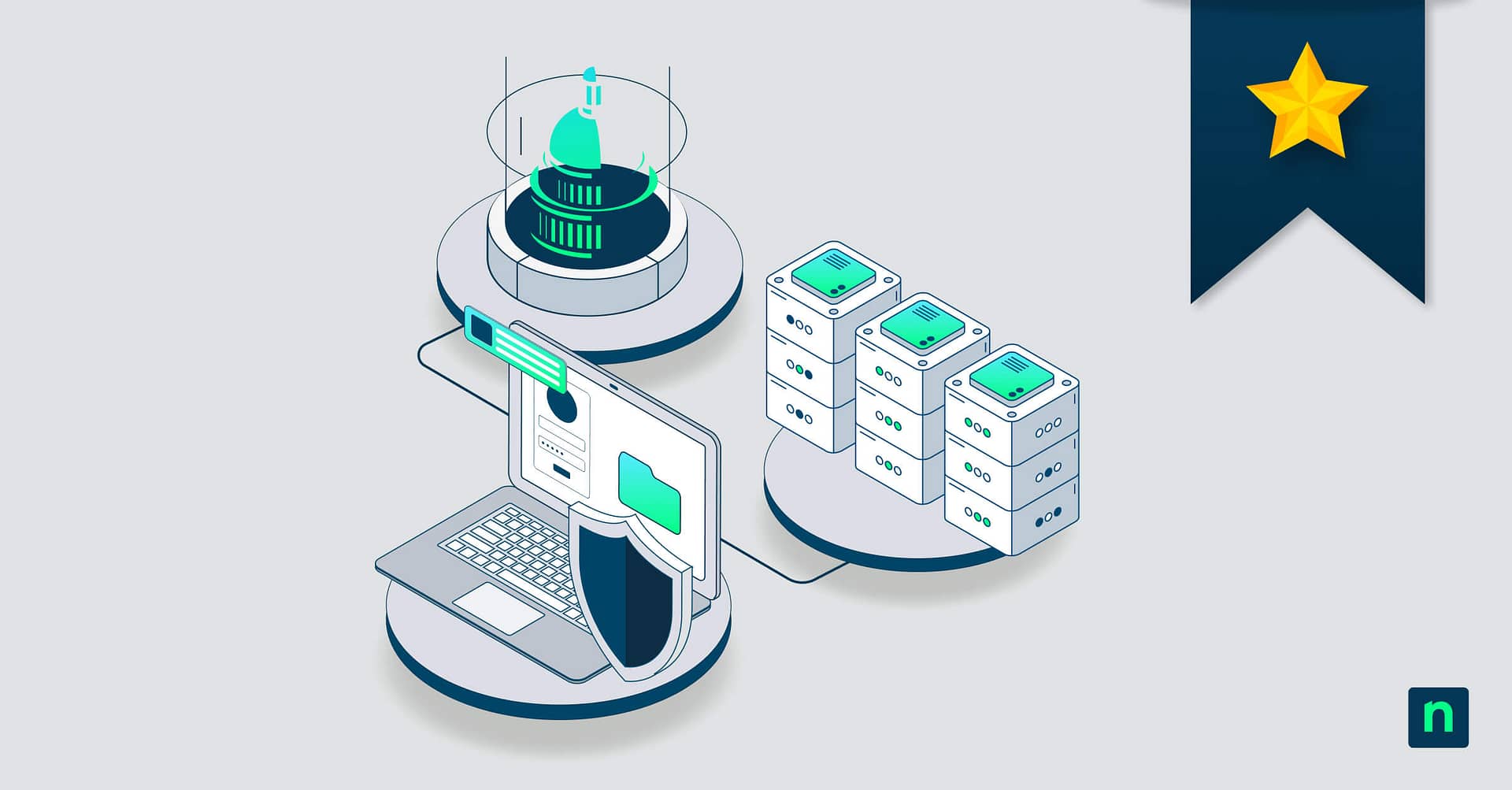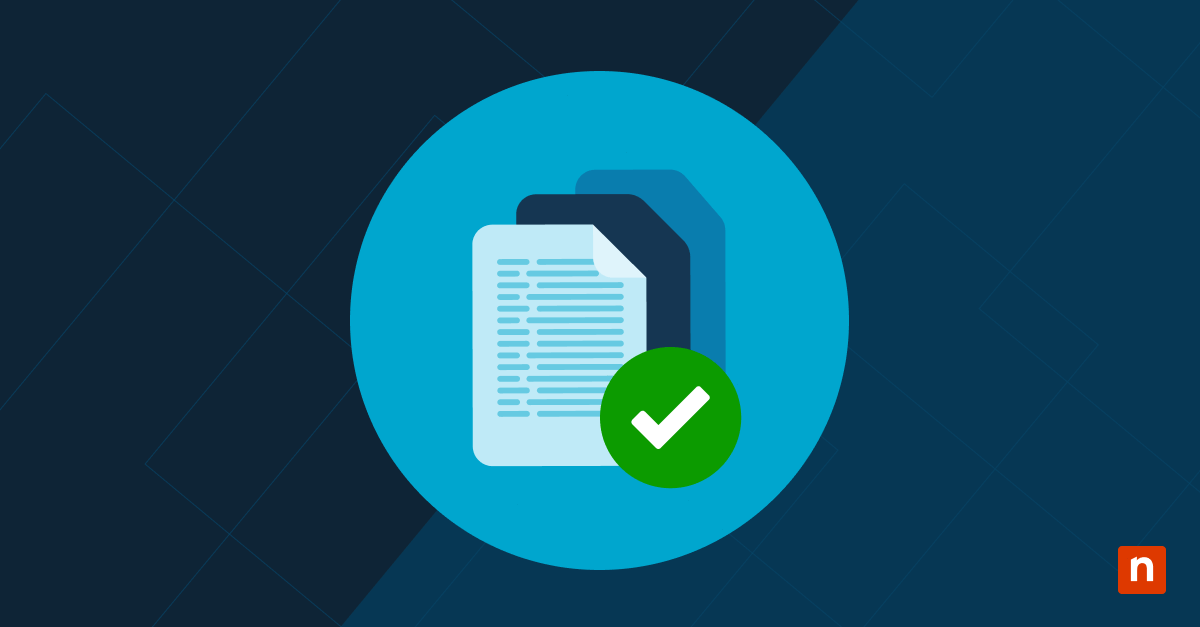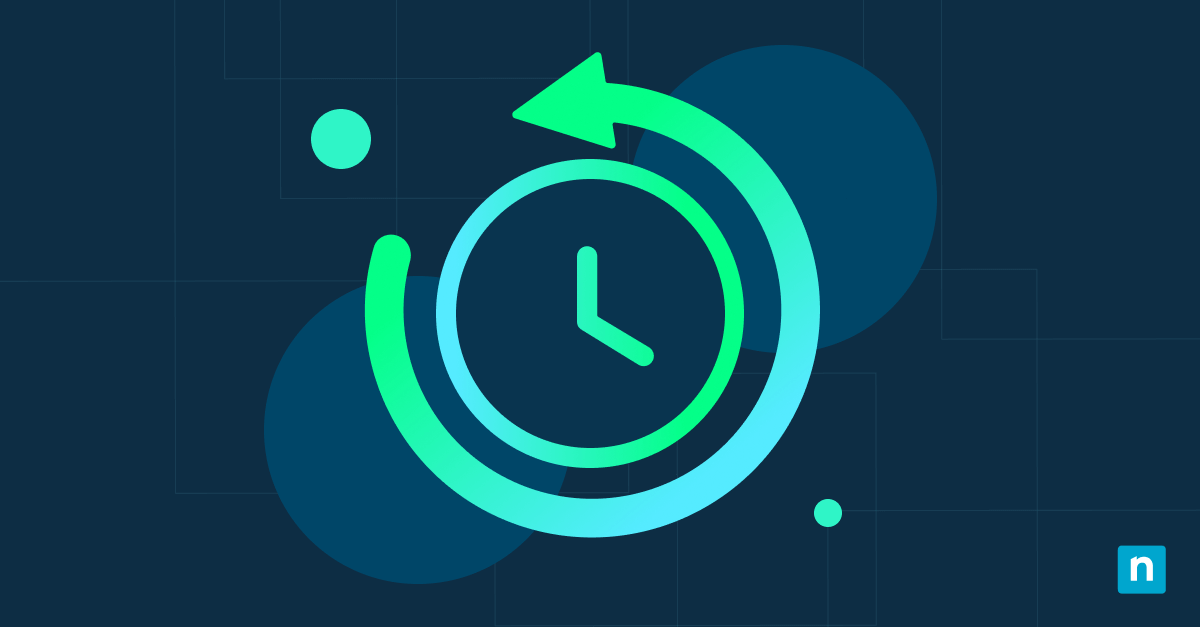Key Points
- NinjaOne leads the market with unified endpoint and SaaS backup, chainless image backup, granular restore options, ransomware protection, and seamless integration into its all-in-one IT management platform—making it ideal for MSPs and IT teams of all sizes.
- Other top tools include:
• Veeam
• Axcient
• Acronis
• Druva
• Rubrik
• Datto BCDR
• Cove Data Protection
• Arcserve
• Commvault - Key features to prioritize: Immutable storage, ransomware protection, chainless/incremental backups, SaaS data recovery, centralized management, and granular restore options across Windows, macOS, Linux, and Microsoft 365.
- Choose based on: Platform reputation, scalability, IT environment compatibility (on-prem, cloud, hybrid), ease of use, customer support quality, and ability to support remote and hybrid workforces.
Data loss or theft can easily destroy a business, but thanks to data backup and recovery solutions, IT teams can rest easy knowing that their data is secure and protected.
No data backup recovery plan is complete without the right software. There are numerous solutions on the market; however, businesses don’t trust just any software solution or provider to access and protect their precious data. They want top-of-the-line tools to keep their information safe. And we have gathered top-of-the-line tools here for you: a list of the best data backup and recovery software for businesses in 2025.
Best backup and recovery tools at a glance
Software | Free Trial | Use Case |
| NinjaOne | 14 days | MSPs and IT teams needing unified endpoint + SaaS backups, chainless image recovery, and ransomware protection in one IT management platform. |
| Veeam Data Platform | 30 days | Enterprises and hybrid IT environments requiring continuous data protection, deep automation, and flexible restore options across physical, virtual, and cloud workloads. |
| Axcient x360Recover | 14 days | MSPs focused on business continuity and disaster recovery, with chain-free backups and both cloud and appliance deployment. |
| Acronis Cyber Protect | 30 days | Organizations wanting integrated backup and cybersecurity with bare-metal restore and endpoint protection from a single dashboard. |
| Druva Data Security Cloud | 30 days | Cloud-first companies seeking a fully SaaS-managed data resilience platform with immutable backups and centralized management. |
| Rubrik | 30 days | Enterprises prioritizing data security, policy-based automation, and cyber recovery with strong compliance and immutability. |
| Datto BCDR | Not publicly listed, but users can request a demo | MSPs managing multiple client environments that need centralized control, instant virtualization, and cloud immutability. |
| Cove Data Protection | 30 days | MSPs needing cloud-first, multi-tenant backup for servers, workstations, and Microsoft 365 with efficient incremental backups. |
| Arcserve UDP | 30 days | SMBs and enterprises seeking image-based backup, ransomware protection, and policy-driven automation in hybrid setups. |
| Commvault Cloud | 30 days | Enterprises needing scalable, policy-driven hybrid or multi-cloud backup with deep analytics, automation, and compliance. |
10 best data backup and data recovery software in 2025
1) NinjaOne
NinjaOne is an all-in-one IT management tool that stands out for its user-friendly interface and world-class customer support. NinjaOne Backup is built into the trusted endpoint management dashboard, protects critical data, helps organizations recover data faster after a cyberattack or disaster, and allows businesses to stay compliant with various regulations like GDPR, PCI-DSS, and HIPAA.
Unified management for scale
This powerful tool delivers flexible and customizable backup with granular options. In addition, NinjaOne Backup offers chainless image backup for servers, allowing businesses to quickly recover from disasters and ensure operational continuity. NinjaOne Backup offers ransomware protection by protecting data with end-to-end encryption and immutable backup storage. All of these features make NinjaOne our top choice for the best data backup and recovery software.
SaaS backup for Microsoft 365 and Google Workspace
NinjaOne also offers SaaS backup for Microsoft 365 and Google Workspace, allowing organizations to protect data created or saved on collaborative cloud-hosted applications. With NinjaOne SaaS Backup, IT professionals can back up all of their SaaS data, from a single file attachment to an entire email system, and then leverage NinjaOne’s granular recovery to restore data as needed.
Additionally, because NinjaOne Backup and SaaS Backup are provided as an add-on to its endpoint management solution, you experience a more holistic and comprehensive approach to managing and safeguarding your endpoints, even as you scale. Overall, with NinjaOne, IT teams have access to all the tools they need to ensure operational continuity, reduce downtime, and comply with regulatory requirements.
Customer story
Steve Park, IT manager at Snyder Langston, was looking for a backup solution for its mostly remote workforce. After trying another vendor, he switched to NinjaOne and was able to remotely manage and back up his team’s Windows and Mac endpoints in a single dashboard.
“We needed something cloud-based that could account for the 70% of our remote workforce,” said Park. “NinjaOne Backup is ‘set and forget’ while being easy to use. It’s critical for our lean IT department to easily back up endpoints for remote workers and executives and helps us be more efficient with our time.”
Read more NinjaOne customer stories or check out NinjaOne reviews.
Protect critical information with NinjaOne’s secure backup and rapid data recovery.
NinjaOne reviews on G2
Category | NinjaOne Rating |
| Overall | 4.7 out of 5 (2,770) |
| Has the product been a good partner in doing business? | 9.5 |
| Quality of Support | 9.2 |
| Ease of Admin | 9.2 |
| Ease of Use | 9.2 |
NinjaOne reviews on Capterra
Category | NinjaOne Rating |
| Overall | 4.7 out of 5 (274) |
| Ease of Use | 4.7 |
| Customer Service | 4.7 |
| Functionality | 4.5 |
| Value for Money | 4.6 |
2) Veeam
Veeam Data Platform is another strong choice as it offers continuous data protection. This software solution provides comprehensive data protection and management capabilities for physical, virtualized, and cloud environments.
It centralizes all the backup tools users need to back up critical data. The solution includes ransomware protection through immutable backup storage, consistent backup schedules through automation, and comprehensive reporting capabilities that help organizations maintain compliance with various regulatory requirements.
Read this article on Veeam alternatives or check out NinjaOne vs Veeam.
Features:
- Automation: IT administrators can automate repetitive tasks, such as scheduling backups or resolving common backup issues. Veeam’s automation tools free up IT teams to focus on more strategic tasks.
- Compliance: Veeam helps IT teams protect sensitive data with real-time monitoring and access control to ensure compliance with regulatory standards like GDPR or HIPAA.
- SaaS Backup:With Veeam, users can back up and rapidly restore their Microsoft 365 data through Veeam Data Cloud (formerly Veeam Backup for Microsoft 365). Note: Support for Google Workspace backup is limited and may require third-party integration.
Shortcomings:
- Interface: According to G2 reviews, Veeam’s feature-rich interface can require a learning curve, particularly for users managing large or multi-site environments.
- Initial setup: Deploying and configuring Veeam may take additional time, especially for organizations integrating advanced automation or custom storage repositories.
- Customer support: While many users praise Veeam’s reliability, feedback indicates that technical support responsiveness and depth can vary depending on the complexity of the issue.
Veeam reviews on G2
Category | Veeam Rating |
| Overall | 4.6 out of 5 (672) |
| Has the product been a good partner in doing business? | 9.0 |
| Quality of Support | 8.9 |
| Ease of Admin | 9.0 |
| Ease of Use | 9.1 |
Veeam reviews on Capterra
Category | Veeam Rating |
| Overall | 4.8 out of 5 (77) |
| Ease of Use | 4.6 |
| Customer Service | 4.5 |
| Functionality | 4.7 |
| Value for Money | 4.6 |
3) Axcient
Axcient x360Recover is a robust business continuity and disaster recovery (BCDR) solution designed primarily for MSPs. The platform covers most modern backup use cases, including appliances, servers, and cloud-to-cloud. It can be delivered and deployed either direct-to-cloud or appliance-based deployment.
Axcient combines backup, disaster recovery, and business continuity features into a single solution, offering both local and cloud-based recovery options. Axcient is also known for its proprietary chain-free backup technology, which eliminates the inefficiencies of chain management and enables organizations to easily comply with HIPAA and GDPR requirements.
Features:
- Granular recovery: Axcient offers multiple options for restoring lost or corrupted data, giving IT teams greater control and flexibility over their data backup and restoration operations.
- Ransomware protection: With its immutable cloud storage and AirGap recovery, Axcient defends backup copies of vital data from ransomware attacks and allows users to restore the data.
- Real-time monitoring: Axcient provides full visibility of backup health and backup history, allowing IT teams to swiftly remediate issues and keep track of all their backups.
Shortcomings:
- User interface: Reviewers often mention that some tools can be difficult to use and that navigation may feel unintuitive due to Axcient’s complex interface.
- Centralized dashboard: While Axcient provides the x360 Portal for multi-product management, some users note that x360Recover’s controls are separate from other Axcient products, requiring additional navigation.
- Customization: Axcient offers strong policy management overall, but some users report limited flexibility in assigning backup policies to individual users or endpoints.
Axcient reviews on G2
Category | Axcient Rating |
| Overall | 4.6 out of 5 (132) |
| Has the product been a good partner in doing business? | 9.0 |
| Quality of Support | 8.7 |
| Ease of Admin | 8.6 |
| Ease of Use | 8.7 |
Axcient reviews on Capterra
Category | Axcient Rating |
| Overall | 4.0 out of 5 (12) |
| Ease of Use | 4.0 |
| Customer Service | 4.0 |
| Functionality | 4.0 |
| Value for Money | 4.3 |
4) Acronis Backup Enterprise
Acronis Backup Enterprise is designed to protect physical servers, virtual machines, and cloud workloads through centralized management and flexible backup options. The platform offers several features, such as bare metal restores, automated backup scheduling, and flexible options for data retention. It is compatible with most mainstream operating systems and hypervisors, allowing IT teams to safeguard diverse infrastructures from a single web-based console.
Read this article on Acronis alternatives or compare NinjaOne vs Acronis.
Features:
- Ransomware protection: Users can protect data from ransomware attacks with Acronis’ integrated Active Protection technology, secure storage options, and both self-recovery and one-click mass recovery capabilities.
- IT automation: IT teams can automate repeatable tasks such as backup scheduling to prevent issues like missed backups due to human error. This allows users to focus on more critical tasks.
- SaaS Backup: Acronis includes support for Microsoft 365 (via Acronis Cyber Protect Cloud), allowing users to quickly restore files, emails, or contacts. Support for Google Workspace is available as an add-on module.
Shortcomings:
- Customer support: Some reviewers on G2 mention that response times could be faster and that technical resolution can vary depending on issue complexity.
- Performance: The Acronis platform experiences slower response times during larger backups and restorations.
- User interface: According to several G2 reviews, advanced configurations require a learning curve, particularly for new users managing complex environments.
Acronis reviews on G2
Category | Acronis Rating |
| Overall | 4.3 out of 5 (706) |
| Has the product been a good partner in doing business? | 8.4 |
| Quality of Support | 8.3 |
| Ease of Admin | 8.5 |
| Ease of Use | 8.6 |
Acronis reviews on Capterra
Category | Acronis Rating |
| Overall | 4.7 out of 5 (6) |
| Ease of Use | 4.3 |
| Customer Service | 4.0 |
| Functionality | 4.3 |
| Value for Money | 4.2 |
5) Druva Data Security Cloud
Druva is a fully managed cloud platform that secures and recovers data from any threat. It is suitable for hybrid environments as it ensures secure recovery through immutable backups. Because its platform is entirely on the cloud, it requires no hardware, software, or appliances to deploy. Instead, IT leaders can easily manage their networks from a single console and experience a scalable solution powered by Amazon Web Services.
Read this article on the top Druva alternatives or check out NinjaOne vs Druva.
Features:
- Ransomware recovery: All backup copies are stored in Druva’s immutable, air-gapped backup storage, ensuring that data is safe from being lost, corrupted, or accessed by unauthorized parties.
- Centralized management: Druva allows users to keep track of backup status, manage backup copies, and restore data from a single console, removing the need to swap tools frequently.
- Secure backups: By utilizing AES 256-bit encryption, Druva ensures that data in transit and at rest is protected from attempts to intercept it.
Shortcomings:
- Storage flexibility: Some users mention that storage capacity can feel limited and would like more flexibility or visibility into available storage tiers.
- Resource-intensive: Backup and recovery operations may take longer for large datasets or resource-intensive workloads.
- Steep learning curve: While Druva’s cloud console is comprehensive, it can take time for new users to become familiar with its full range of capabilities.
Druva reviews on G2
Category | Druva Rating |
| Overall | 4.7 out of 5 (676) |
| Has the product been a good partner in doing business? | 9.4 |
| Quality of Support | 9.4 |
| Ease of Admin | 9.3 |
| Ease of Use | 9.4 |
Druva reviews on Capterra
Category | Druva Rating |
| Overall | 4.7 out of 5 (17) |
| Ease of Use | 4.5 |
| Customer Service | 4.7 |
| Functionality | 4.6 |
| Value for Money | 4.5 |
6) Rubrik
Rubrik allows IT teams to protect their data, monitor data risk, and recover data and applications to maintain operational efficiency. IT teams can use Rubrik to back up endpoint devices, operating systems, virtual machines, and SaaS data. Rubrik’s policy-driven automation frees up IT professionals from manually working on repetitive backup tasks, allowing them to focus on more complex or critical tasks. In addition, Rubrik allows businesses to recover from cyberattacks, ransomware, disasters, or even human error thanks to its quick recovery capabilities.
Read this article on Rubrik alternatives.
Features:
- Policy enforcement: Thanks to Rubrik’s policy enforcement tools, users have complete control over backup frequency and data retention.
- SaaS Backup: The platform offers data backup capabilities for SaaS applications, such as Microsoft 365. Rubrik can recover data, files, and mailboxes, minimizing disruptions from cyberattacks.
- Remote monitoring: Rubrik highlights its risk monitoring feature, which can detect potential ransomware infections and indicators of data integrity being compromised.
Shortcomings:
- Granular recovery: Reviewers report that Rubrik could offer more granular restore options.
- Ease of use: Rubrik users say that the platform’s GUI could be more user-friendly, and using advanced features can be difficult.
- Reporting: While Rubrik provides built-in reporting, several users would like more customization options to tailor reports to specific compliance or audit requirements.
Rubrik reviews on G2
Category | Rubrik Rating |
| Overall | 4.6 out of 5 (97) |
| Has the product been a good partner in doing business? | 9.2 |
| Quality of Support | 8.9 |
| Ease of Admin | 9.2 |
| Ease of Use | 9.4 |
Rubrik reviews on Capterra
Category | Rubrik Rating |
| Overall | 4.8 out of 5 (73) |
| Ease of Use | 4.7 |
| Customer Service | 4.7 |
| Functionality | 4.6 |
| Value for Money | 4.5 |
7) Datto BCDR
Datto SIRIS BCDR is known for its reliability, unlimited cloud storage, fast recovery, and granular data restoration. It also provides automated SaaS backup for Google Workspace and Microsoft 365. Additionally, it boasts more than a decade cloud-to-cloud backup innovation and a record of consistent performance. The solution provides centralized management through a web-based portal that allows MSPs to monitor backup status, manage recovery points, and restore data across multiple client environments.
Features:
- Rapid data recovery: Datto offers multiple options, from file-level recovery to a full bare metal restore. Organizations can quickly restore important data to continue operations even after a major disaster or outage.
- Secure storage: This platform’s cloud-native storage is immutable, preventing unauthorized users from accessing any of the backup copies.
- Centralized management: Datto consolidates multiple tools that IT professionals can use to protect sensitive data into a single dashboard, improving the efficiency of backup operations.
Shortcomings:
- Customer support: Response times can vary, and some users have said that support resolution may take longer during complex recovery scenarios.
- Non-Windows system compatibility: According to reviews, Datto lacks support for macOS and only offers limited support for Linux systems. Additionally, restoring data for Linux is a more complicated process.
- Flexibility: Datto BCDR’s restoration options are limited compared to competitors, according to G2 reviews.
Datto reviews on G2
Category | Datto Rating |
| Overall | 4.6 out of 5 (248) |
| Has the product been a good partner in doing business? | 9.1 |
| Quality of Support | 8.6 |
| Ease of Admin | 9.3 |
| Ease of Use | 9.3 |
Datto reviews on Capterra
Category | Datto Rating |
| Overall | 4.6 out of 5 (90) |
| Ease of Use | 4.5 |
| Customer Service | 4.4 |
| Functionality | 4.6 |
| Value for Money | 4.2 |
8) Cove Data Protection
Cove Data Protection by N-Able is a cloud-first data-as-a-service tool. Business leaders use it for its ease of management and efficiency in backing up various workloads.
It also offers recovery services for servers, workstations, and Microsoft 365 from a multi-tenant web-based dashboard. Cove highlights its incremental backups to minimize resource usage, which is 60x smaller than image backups, freeing up resources for more frequent backups.
Read this article on Cove Data Protection alternatives or check out NinjaOne vs Cove Data Protection.
Features:
- Multitenant management: Designed to secure data in multitenant environments, Cove allows MSPs to manage multiple clients at once.
- Secure storage: Cove Data Protection offers end-to-end encryption, protecting data in transit and at rest with robust AES 256-bit encryption.
- Ransomware recovery: To ensure that data is always recoverable, backups are encrypted and isolated in immutable cloud storage.
Shortcomings:
- User interface: Users have expressed that the user experience when using Cove could be improved.
- Customer support: Response times for support tickets can vary, and a few users mention delays during busy periods.
- Performance: Restoring large datasets or operating in low-bandwidth environments can take longer than expected, depending on connection speed and data volume.
Cove Data Protection reviews on G2
Category | Cove Data Protection Rating |
| Overall | 4.5 out of 5 (405) |
| Has the product been a good partner in doing business? | 8.9 |
| Quality of Support | 8.5 |
| Ease of Admin | 8.9 |
| Ease of Use | 9.0 |
Cove Data Protection reviews on Capterra
Category | Cove Data Protection Rating |
| Overall | 4.7 out of 5 (216) |
| Ease of Use | 4.7 |
| Customer Service | 4.5 |
| Features | 4.5 |
| Value for Money | 4.4 |
9) Arcserve
Arcserve UDP is a data resilience platform that offers data backup and recovery features to safeguard vital data from cyberattacks and data loss. With features like image-based backups and granular file recovery, IT teams can reduce downtime and ensure business continuity. By centralizing all the tools IT administrators need to monitor backup statuses, manage retention policies, and perform data restore operations into a single console, Arcserve helps improve an organization’s security posture by protecting data in transit and at rest with end-to-end encryption.
Read this article on Arcserve alternatives or check out NinjaOne vs Arcserve.
Features:
- Granular restore options: Arcserve provides IT administrators with multiple options for data restoration, allowing users to recover single files or entire systems.
- Policy enforcement: Users can determine and enforce policies for consistent data protection. This feature also makes Arcserve a highly scalable solution.
- Ransomware protection: By encrypting data and storing backup copies in secure storage, Arcserve ensures that users always have a copy of important data.
Shortcomings:
- Customer support: According to G2 reviews, Arcserve’s customer service can be inconsistent, and users often wait some time to get a response from the support team.
- Interface: Arcserve’s GUI contains multiple management windows, which can make navigation less intuitive for new users.
- Backup reliability: Some customers have noted that automated backups may occasionally fail due to licensing or configuration issues, requiring manual intervention to resolve.
Arcserve reviews on G2
Category | Arcserve Rating |
| Overall | 4.2 out of 5 (139) |
| Has the product been a good partner in doing business? | 8.4 |
| Quality of Support | 8.2 |
| Ease of Admin | 8.0 |
| Ease of Use | 7.9 |
Arcserve reviews on Capterra
Category | Arcserve Rating |
| Overall | 4.7 out of 5 (9) |
| Ease of Use | 4.6 |
| Customer Service | 3.6 |
| Features | 4.2 |
| Value for Money | 3.9 |
10) Commvault
Commvault is a cloud-first backup solution designed specifically for MPS and IT professionals managing multiple client environments. The platform offers file-level and image-based backups for servers, workstations, and Microsoft 365 data.
Commvault allows users to automate their backup and recovery processes to ensure consistent backups. Features such as policy management and advanced analytics for compliance reporting allow organizations to remain compliant with regulatory standards.
Read this article on Commvault alternatives or check out NinjaOne vs Commvault.
Features:
- Secure cloud storage: By storing backup copies in immutable, air-gapped cloud storage, Commvault protects critical data from tampering or corruption.
- SaaS backup: Users can also back up and restore data from Microsoft 365. This allows IT teams to protect SaaS data such as emails, documents, and more.
- Policy enforcement: Commvault enables users to enforce policies to automate processes, improving operational efficiency.
Shortcomings:
- Steep learning curve: Commvault offers deep functionality, but mastering its full feature set can take time, particularly for smaller teams or new users.
- Customer support: Feedback suggests that resolution times can vary, and more complex support requests may take longer to close.
- Setup: According to reviews, Commvault’s initial setup and configuration can require detailed planning, especially in multi-environment or enterprise-scale deployments.
Commvault reviews on G2
Category | Commvault Rating |
| Overall | 4.4 out of 5 (175) |
| Has the product been a good partner in doing business? | 8.6 |
| Quality of Support | 8.8 |
| Ease of Admin | 8.2 |
| Ease of Use | 7.9 |
Commvault reviews on Capterra
Category | Commvault Rating |
| Overall | 4.6 out of 5 (48) |
| Ease of Use | 4.4 |
| Customer Service | 4.6 |
| Features | 4.5 |
| Value for Money | 4.5 |
Comparison of the best data backup and data recovery software (G2)
| Category | NinjaOne | Veeam | Axcient | Acronis | Druva | Rubrik | Datto | Cove Data Protection | Arcserve | Commvault |
| Overall | 4.7 out of 5 (2,770) | 4.6 out of 5 (672) | 4.6 out of 5 (132) | 4.3 out of 5 (706) | 4.7 out of 5 (676) | 4.6 out of 5 (97) | 4.6 out of 5 (248) | 4.5 out of 5 (405) | 4.2 out of 5 (139) | 4.4 out of 5 (175) |
| Has the product been a good partner in doing business? | 9.5 | 9.0 | 9.0 | 8.4 | 9.4 | 9.2 | 9.1 | 8.9 | 8.4 | 8.6 |
| Quality of support | 9.2 | 8.9 | 8.7 | 8.3 | 9.4 | 8.9 | 8.6 | 8.5 | 8.2 | 8.8 |
| Ease of Admin | 9.2 | 9.0 | 8.6 | 8.5 | 9.3 | 9.2 | 9.3 | 8.9 | 8.0 | 8.2 |
| Ease of Use | 9.2 | 9.1 | 8.7 | 8.6 | 9.4 | 9.4 | 9.3 | 9.0 | 7.9 | 7.9 |
Comparison of the best data backup and data recovery software (Capterra)
Category | NinjaOne | Veeam | Axcient | Acronis | Druva | Rubrik | Datto | Cove Data Protection | Arcserve | Commvault |
| Overall | 4.7 out of 5 (274) | 4.8 out of 5 (77) | 4.0 out of 5 (12) | 4.7 out of 5 (6) | 4.7 out of 5 (17) | 4.8 out of 5 (73) | 4.6 out of 5 (90) | 4.7 out of 5 (216) | 4.7 out of 5 (9) | 4.6 out of 5 (48) |
| Ease of Use | 4.7 | 4.6 | 4.0 | 4.3 | 4.5 | 4.7 | 4.5 | 4.7 | 4.6 | 4.4 |
| Customer Support | 4.7 | 4.5 | 4.0 | 4.0 | 4.7 | 4.7 | 4.4 | 4.5 | 3.6 | 4.6 |
| Functionality | 4.5 | 4.7 | 4.0 | 4.3 | 4.6 | 4.6 | 4.6 | 4.5 | 4.2 | 4,5 |
| Value for Money | 4.6 | 4.6 | 4.3 | 4.2 | 4.5 | 4.5 | 4.2 | 4.4 | 3.9 | 4.5 |
Final scores and summaries of IT automation software for IT professionals
Vendor | Final Score | Summary |
| NinjaOne | 3.618 | NinjaOne is our choice as the best data backup and recovery software, as it allows MSPs and IT teams to safeguard and restore endpoint and SaaS data. NinjaOne Backup automates backup processes and protects data from ransomware with its end-to-end encryption and immutable cloud storage. |
| Veeam | 1.311 | Veeam Data Platform provides comprehensive data protection with ransomware protection, immutable backups, automation, and reporting. |
| Druva | 1.264 | Druva is a cloud-based platform that secures and recovers data from any threat that’s most suitable for hybrid environments. |
| Acronis | 1.244 | Acronis Backup Enterprise protects data on physical servers, virtual machines, and cloud workloads through centralized management and automation for backup processes. |
| Cove Data Protection | 1.176 | N-Able’s Cove Data Protection offers data backup services for servers, workstations, and Microsoft 365 from a multi-tenant web-based dashboard. |
| Datto | 0.896 | Datto SIRIS BCDR provides centralized management to allow MSPs and IT teams to monitor backup status and restore data across multiple client environments. |
| Commvault | 0.758 | Commvault allows users to easily manage multiple client environments with file-level and image-based backups for servers, workstations, and Microsoft 365 data. |
| Rubrik | 0.739 | Rubrik is a software solution that allows IT teams to protect business-critical data, monitor data risk, and recover data and applications to ensure business continuity. |
| Arcserve | 0.676 | Arcserve UDP is a data resilience platform that offers features to safeguard vital data from cyberattacks and data loss. |
| Axcient | 0.673 | Axcient x360Recover combines backup, disaster recovery, and business continuity features into a single solution, offering both local and cloud-based recovery options. |
Our rankings formula
To derive the final score for each vendor, we employed a weighted formula that considers various metrics. Here’s how it breaks down:
Final Score = w1 * G2 Overall Star Rating + w2 * Capterra Overall Star Rating + w3 * G2 Good Partner in Doing Business + w4 * Capterra Customer Support + w5 * G2 Total Number of Reviews (Scaled) + w6 * Capterra Total Number of Reviews (Scaled) + Other Factors
w1 = 0.15 (Weight for G2 Overall Star Rating)
w2 = 0.15 (Weight for Capterra Overall Star Rating)
w3 = 0.2 (Weight for G2 Good Partner in Doing Business)
w4 = 0.2 (Weight for Capterra Customer Support)
w5 = 0.1 (Weight for G2 Total Number of Reviews, Scaled)
w6 = 0.1 (Weight for Capterra Total Number of Reviews, Scaled)
Other Factors include additional metrics like ease of use, each multiplied by its corresponding weights:
w7 = 0.05 (Weight for G2 Ease of Use)
w8 = 0.05 (Weight for Capterra Ease of Use)
Tips for choosing the best data backup and data recovery software
Out of all these data software options, how do organizations choose one? When evaluating this type of software, here are some factors to consider:
1. See what other users and IT professionals are saying
Even if the provider you are considering is well-known, always check the company’s reputation and reviews. There are many ways to use peer-review websites for software to gather additional information about a provider and its services.
2. Understand the features offered by each provider
When comparing two similar software solutions, note their backup and recovery capabilities, specifically the features that will benefit your organization. Some examples of features to look for include disaster recovery plans, RTO and RPO, backup frequency, and granularity of restored data.
3. Ensure compatibility with current systems
Unless your IT team plans to alter all their current systems, ensure that the software that you select is compatible with your IT environment. Your new software solution should solve problems, not create them due to compatibility issues.
4. Verify your preferred solution is scalable
If you are a growing MSP or IT team, purchase a software solution that offers multiple scalability options. This way, the software can grow with your company during times of success, and you can also revert it back if needed.
5. Determine if you need on-site, remote, or hybrid support
A 2025 Gallup poll found that 28% of US companies are now exclusively remote, 21% are on-site, and 51% work under a hybrid model. The software provider you partner with should provide their services and support for the business model you follow, including on-site, remote, or hybrid environments.
7 qualities to look for in data backup and data recovery software
In general, seven qualities determine great software. But since we’re talking specifically about data backup and recovery tools, we discussed how these qualities must also be found in any backup platform you eventually decide on.
User experience (UX)
Arguably, the most important quality of any software, user experience describes a person’s overall feeling when using the platform. This includes loading time and how visually appealing the software is. Take note that 40% of people will leave a site if it takes more than three seconds to load, and 32% of customers will leave a brand (even one they loved) after just one bad experience (Baymard Institute).
✅ Application to data backup and recovery software: More IT experts recommend regularly backing up data (it would be better if you can automate this procedure) so that in the event of a ransomware attack, your IT team has fail-safes in place to minimize any organizational impact.
Availability
Availability measures the probability that a system is operational. In other words, how often does the software work? If software crashes regularly or is inaccessible for whatever reason, it will rate poorly for availability.
✅ Application to data backup and recovery software: Ideally, you shouldn’t be using your data recovery tool a lot. Nevertheless, it is important that when you need to, your software works efficiently and effectively.
Performance
As its name suggests, performance determines how effective the software is compared to the expected workload, estimated IT budget, and other variables.
✅ Application to data backup and recovery software: This works hand-in-hand with availability. It is important that your tool can successfully handle backing up data when it needs to.
Scalability
Good software remains functional and efficient even as it handles more processes. If you’re an MSP, MSSP, or IT enterprise, you must consider software proven to remain fast and reliable even as you grow.
✅ Application to data backup and recovery software: As your company grows, it is likely that you will have large amounts of data to back up and recover. Make sure that you work with a software vendor that is known to remain fast and reliable, even when managing heavier backup loads.
Adaptability
Software adaptability describes the ease with which it can adapt to changing requirements. Given the ever-evolving IT landscape, this is particularly important in data backup and data recovery tools.
✅ Application to data backup and recovery software: Unlike other types of software, data backup and recovery tools are not often changed or modified. That said, it’s still worth considering how well your desired tool can adapt to your business needs.
Security
It is vital that your software can mitigate threats, such as ransomware. This includes implementing authentication protocols, such as MFA, and complying with various regulations like SOC.
✅ Application to data backup and recovery software: Look for a data backup software vendor that has a proven track record of safeguarding data and its endpoints. Companies that integrate with antivirus software, like NinjaOne, are also worth considering.
Economy
This measures the total cost of ownership of the software and includes how much you spend on it during deployment and maintenance. Ideally, your software should offer a decent ROI compared to the other six qualities.
✅ Application to data backup and recovery software: Your chosen platform should not cost you an arm and a leg to manage. Find software that is not only efficient to manage, but also contributes to your overall bottom line.
Windows vs. Mac backup and data recovery software
You may wonder if there is a difference between Windows and Mac data backup and data recovery, aside from the obvious distinction of the type of devices they manage.
While all types of backup software perform essential tasks, they usually differ in ease of use and the amount of data that can be stored in the cloud or on-premises.
This is where it can get tricky: Some users have stated that Windows backup software is generally slower and more prone to glitches than Mac backup software. However, some groups state the opposite and claim Mac software is less reliable than its Windows counterpart.
Ultimately, it seems to boil down to personal choice. It’s worth noting that all vendors offer the same core functions but shine in specific areas—including device type management. This point is worth emphasizing: Always look at the type of devices your intended vendor can back up. To mitigate risks, it is best to find a solution that can back up multiple devices across several operating systems.
Bounce back from any disaster, cyberattack, system failures, or even accidental deletions with reliable, secure backup and recovery.
Protect and secure your data with NinjaOne Backup
Now that you have a better idea of the best data backup and data recovery software on the market, you’ll have an easier time finding the top platform for your organization. Consider your business’s pain points and list down important features, such as ransomware protection, and compare these factors against each software’s features. In the end, the best software is the one that answers your organization’s specific requirements.
NinjaOne helps drive radical efficiency for MSPs and IT enterprises with its all-in-one tool that centralizes all the tools users need to secure IT environments and critical business data. Its data backup and recovery platform, NinjaOne Backup, allows IT teams to back up crucial data and rapidly recover any data to ensure business continuity. Over 20,000 customers worldwide use NinjaOne Backup to protect their data, remain compliant, and recover faster with a tool that does more for less.
If you’re ready, request a free quote, sign up for a 14-day free trial, or watch a demo.

